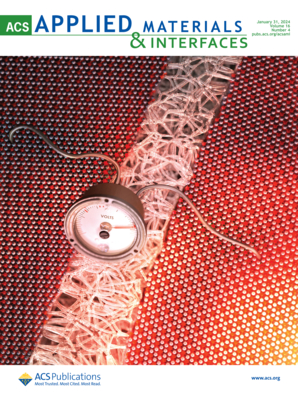用于高效醇电氧化的多金属纳米棒的原子缺陷外延生长
IF 8.3
2区 材料科学
Q1 MATERIALS SCIENCE, MULTIDISCIPLINARY
引用次数: 0
摘要
金属在形状纳米颗粒上的选择性外延生长代表了一种定制纳米结构以优化光学和催化性能的通用策略。在这项研究中,我们系统地阐明了控制银和铂原子在金纳米棒(Au NRs)上外延生长的关键因素,揭示了Au NR表面的原子缺陷决定了Ag和Pt的沉积位置。通过精确调节外延生长条件和表面原子缺陷的密度,我们实现了哑铃形(DS)和刺壳(TS)结构Au- agpt NRs的合成。值得注意的是,DS-Au-AgPt0.24 NR催化剂在醇燃料电池反应中表现出了优异的催化性能,这是由于其丰富的原子缺陷和位于冠状结构上的强应变效应。对于乙二醇电氧化,DS-Au-AgPt0.24 nmr的质量活性为23.5 a mgPt-1,比活性为156.9 mA cm-2,分别是商业铂碳(Pt/C)催化剂(5.7 a mgPt-1和14.0 mA cm-2)的4.1和11.2倍。我们的发现不仅促进了对多金属体系中缺陷介导外延生长机理的理解,而且为通过原子尺度结构工程设计高性能催化剂提供了蓝图。本文章由计算机程序翻译,如有差异,请以英文原文为准。

Atomic Defect-Directed Epitaxial Growth of Multimetallic Nanorods for High-Efficiency Alcohol Electro-Oxidation
Site-selective epitaxial growth of metals onto shaped nanoparticles represents a versatile strategy for tailoring nanostructures to optimize the optical and catalytic properties. In this study, we systematically elucidate the critical factors governing the epitaxial growth of silver and platinum atoms onto gold nanorods (Au NRs), revealing that atomic defects on the Au NR surface dictate the deposition sites of Ag and Pt. By precisely modulating epitaxial growth conditions and density of surface atomic defects, we achieve the synthesis of dumbbell-shaped (DS) and thorny-shell (TS) structured Au-AgPt NRs. Notably, the DS-Au-AgPt0.24 NR catalyst demonstrated exceptional catalytic performance in alcohol fuel cell reactions, driven by their abundant atomic defects and strong strain effects localized at the crown structure. For ethylene glycol electro-oxidation, these DS-Au-AgPt0.24 NRs achieved a mass activity of 23.5 A mgPt–1 and a specific activity of 156.9 mA cm–2, which were 4.1 and 11.2 times higher than that of commercial platinum–carbon (Pt/C) catalysts (5.7 A mgPt–1 and 14.0 mA cm–2), respectively. Our findings not only advance the mechanistic understanding of defect-mediated epitaxial growth in multimetallic systems but also provide a blueprint for designing high-performance catalysts through atomic-scale structural engineering.
求助全文
通过发布文献求助,成功后即可免费获取论文全文。
去求助
来源期刊

ACS Applied Materials & Interfaces
工程技术-材料科学:综合
CiteScore
16.00
自引率
6.30%
发文量
4978
审稿时长
1.8 months
期刊介绍:
ACS Applied Materials & Interfaces is a leading interdisciplinary journal that brings together chemists, engineers, physicists, and biologists to explore the development and utilization of newly-discovered materials and interfacial processes for specific applications. Our journal has experienced remarkable growth since its establishment in 2009, both in terms of the number of articles published and the impact of the research showcased. We are proud to foster a truly global community, with the majority of published articles originating from outside the United States, reflecting the rapid growth of applied research worldwide.
 求助内容:
求助内容: 应助结果提醒方式:
应助结果提醒方式:


